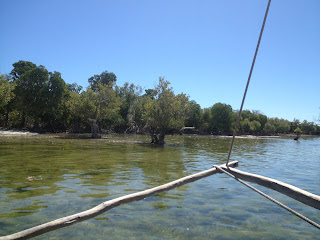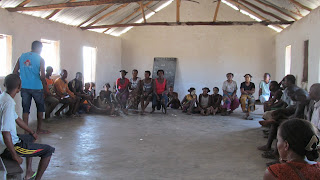 |
| Mangroves = carbon = schools |
By registering the Bay of Assassins mangrove forests as a Plan Vivo project, Blue Ventures, as the project manager, will be able to channel money to communities through the sale of certificates for carbon credits on the open market. The certifier - in this case Plan Vivo, although there are other carbon standards - ensures that these certificates are backed up verifiable trees just standing around in the forest, sequestering carbon. And if they’re mangrove forests, the trees, soil and roots together add up to an ecosystem that can hold more carbon than many other forest types.
 |
| A few potential beneficiaries of the project |
However, the preparation and planning that goes into validation of the project - that is, ensuring that carbon credits sold as certificates can be traced back to their origin from sustainably managed forests, supported by biomass volume calculations - has an enormous amount of work going on behind the scenes.
The primary consideration is that the people in the communities are full participants in, and leaders of, the process. The Blue Forests team working in the area; Lalao, our project coordinator, Cicelin, Dolce and Aina, have visited and re-visited each of ten villages; to first conduct information sessions to assess interest and commitment on the part of the communities, then to systematically guide them through the process. I’ve joined the project close to the end of the many consultations, as we expect to be able to finish this stage by July.
 |
| Village consultation |
The villagers have discussed and agreed upon zonation of protected areas (no harvest of trees at all), sustainable use areas and planned reforestation areas. (The goal is to plant 10 hectares of mangrove each year until the degraded forest is completely covered in mangrove again.) To ensure that no harvest occurs from protected areas and that cut quotas are respected in the sustainable use areas, communities have also agreed on local rules (Dina) and as a result, have also planned a system to enforce the rules. One of the major issues throwing a wrench into control of mangrove forests by communities is that outsiders often come into the area, cut trees and transport them away for sale of the wood or to make charcoal. Everyone has agreed that monthly or bi-monthly patrols are necessary - which means that locals must be recruited and trained to monitor the forests and report infractions to the village and district associations.
 |
| Dolce, leading the consultation in the Ankitambagna school, on the list to be replaced |
Discussions have been had around what to do with the money earned through sale of carbon credits, with most villagers approving the construction of new schools, or meeting halls, or markets. Actual earnings, spread out over 20 years of the project, probably won’t be enough to completely fund the infrastructure, but will buy materials, and it is expected that communities will provide the labour for construction. However, some villages will have to wait for their share, and another consultation will be held to agree on the priority sites and to create a schedule for each villages’ needs.
 |
| One of our coastal villages |
The latest meetings were held over the last two weeks to discuss benefit sharing and to explain division of the funds that will be earned. A percentage each year is set aside for monitoring and protection of the forest, some portion will be remitted to the larger area association and national government and at least 50%, possibly more, will be available for community projects. Generally, interest in these consultations varies between villages, but the presidents of the communities attended a workshop before this round and they all clearly explain the issues that are being brought before the residents for consideration, and consensus is reached through open, and sometimes vigorous, discussion.
In the next 3 months, we have at least 3 more village tours on the calendar; for benefit sharing with the discussion on infrastructure priorities, consultations to design a grievance mechanism and final validation of the whole project by each community. The process requires continuous, dedicated effort on behalf of the Blue Forests team in the Southwest and so far, they’re advancing the ball steadily and surely - we’ll get there.
The best part for me about this round of consultations? The commute - a sweet hour in a sailing pirogue to get to Lomboara on the last day before wrapping up the tour.
 |
| Aina, one of the Blue Forests team members, at home on the pirogue |
 |
| Obligatory (for me) baobab picture (expect more) |


















